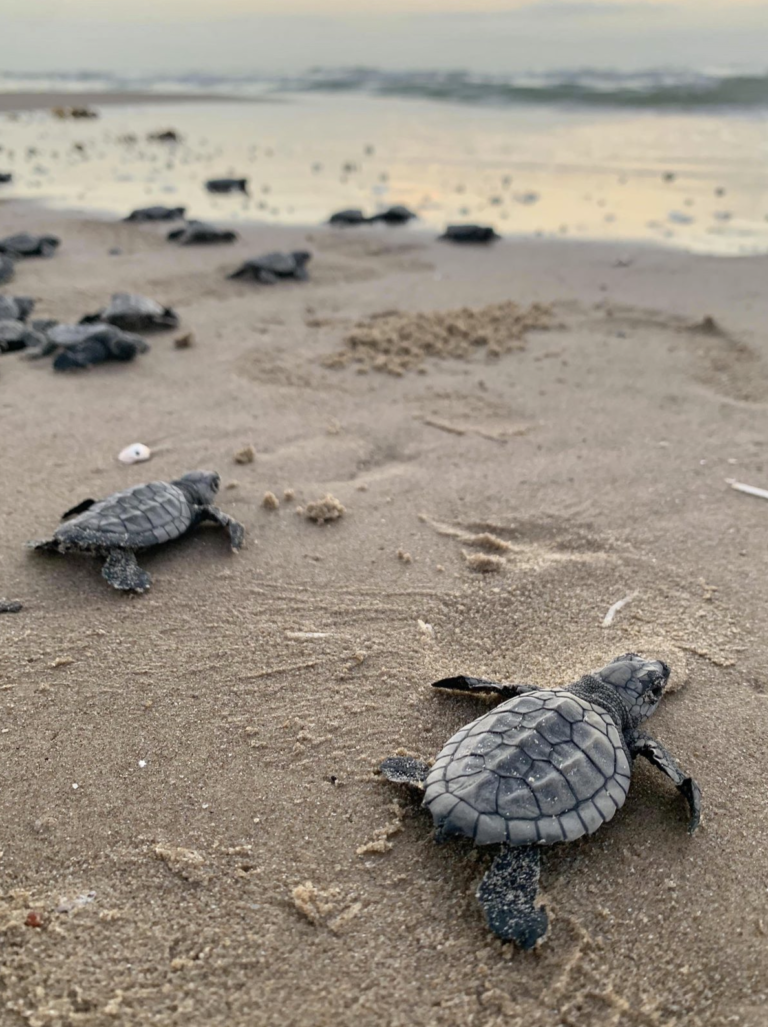Species in Peril:
KEMP'S RIDLEY SEA TURTLES

The most endangered of all sea turtles
Also the smallest of them all
The Kemp’s Ridley Sea Turtle is the smallest sea turtle in the world reaching only two feet in shell length and weighing up to 100 pounds. It has a triangular-shaped head with a slightly hooked beak. Adults are a greyish-green color on top and on the bottom, they have a pale yellowish bottom shell. Each of the front flippers has one claw, while the back flippers may have one or two.
This turtle’s diet consists mainly of swimming crabs, but may also include fish, jellyfish, and mollusks. They find these in shallow waters where they prefer to reside. The juveniles tend to live in floating seaweed beds for the first few years.
Synchronized nesting habits
Most females return to a single beach in Rancho Nuevo, Mexico to lay their eggs. These females come ashore in large groups called arribada, which means arrival in Spanish. There are many theories on what triggers an arribada, including offshore winds, lunar cycles and the release of pheromones by females. Additionally, some biologists think nesting in groups is a strategy to reduce predation by overwhelming predators with numbers.
The Kemp’s Ridley sea turtle nests from April to July and unlike the other species of turtles that nest at night the Kemp’s Ridley nests during the day. Some think this is to avoid nighttime predators. Each turtle lays 2-3 clutches per season and they return to the beach to nest every 1-3 years. The females lay approximately 100 eggs in the sand, which incubate for 50 to 60 days.
When the eggs hatch the baby turtles orient seaward and crawl towards the horizon.
Cold stun-event
Kemp’s ridley turtles prefer water temperatures in the 70s and 80s. This makes the gulf of Maine and around the Cape suitable for them in the summer. However, winters often bring cold temperatures that spell disaster for these sea turtles, who get hypothermic, which no longer allow them to swim. The event is called cold stun.
Due to climate change, these cold stun events are becoming more common and affecting more sea turtles than ever before. In 2020, when Texas experienced a week-long cold snap, thousands of sea turtles and hundreds of Kemp’s Sea Turtles would have died if it had not been for the hundreds of volunteers who helped save them and bring them to sanctuaries that kept them safe until the temperatures warmed again and the sea turtles were all released back to sea.
A Few More Facts About Kemp's Ridley Sea Turtles
- These turtles have an estimated lifespan of up to 30 years
- The Kemp’s Ridley turtle does not reach maturity until 13 years of age this is when they can nest
- These turtles change colors as they mature from purple to yellow-green.
- Their population declined to less than 300 females in 1985
- These turtles were directly affected by the Deepwater Horizon oil spill.
- The Texas State Legislature has even designated the Kemp’s ridley as the Texas State Turtle
Saving the Kemp's Ridley Sea Turtles
They are in Danger of Extinction
The Kemp’s Ridley Sea Turtles are critically endangered and humans must play a role in saving the species. If you would like to learn more about this species and wish to donate to their cause, please visit the following sites:
www.seaturtleinc.org
www.pegasusfoundation.org
Species Name
Lepidochelys kempli
Estimated Population
7,000-9,000 nesting females
Conservation Status
Critically Endangered
Range
Northern Gulf of Mexico, near Louisiana waters.
South Padre Island, TX where they nest.
Reasons for Population Decline
Bycatch in Fishing Gear
Harvest of Turtles and Eggs
Loss and Degradation of Nesting Habitat
Ocean Pollution/Marine Debris
Vessel Strikes
Climate Change


